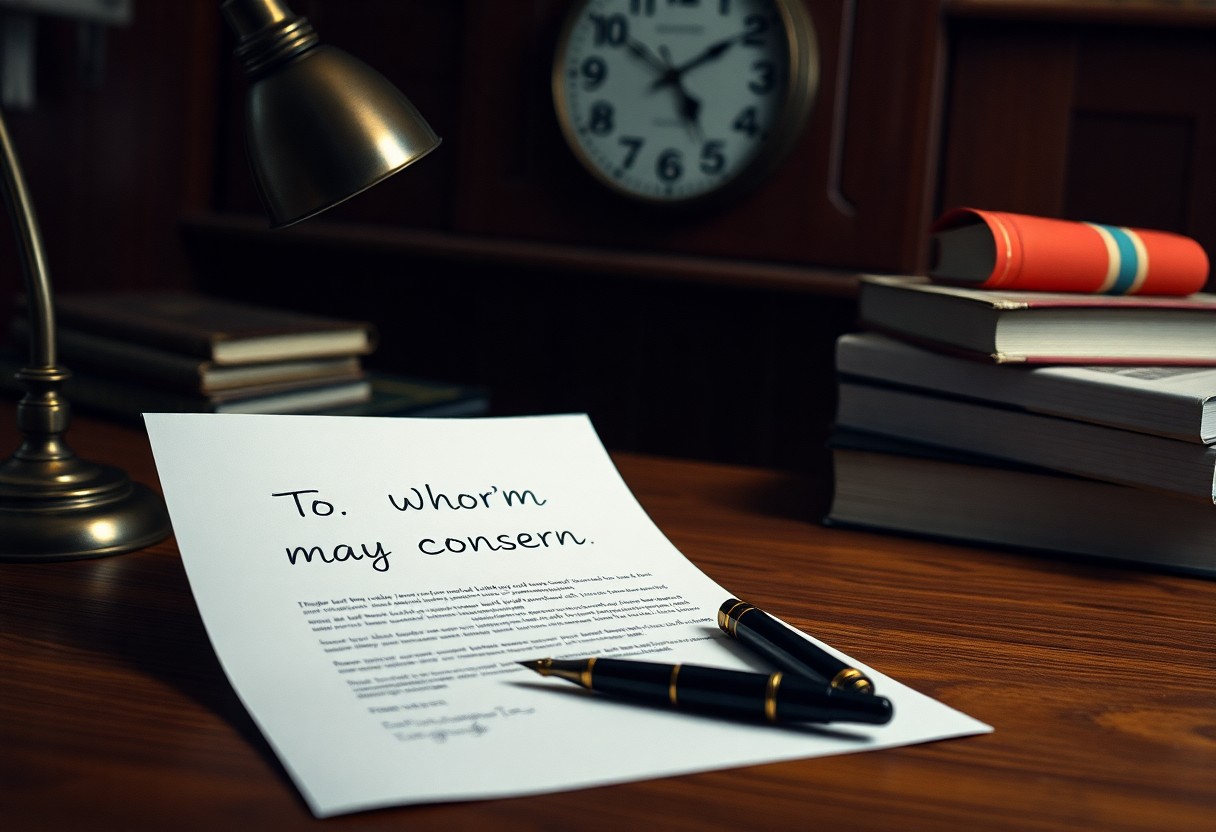There’s a lot to gain from understanding the ‘To Whom It May Concern’ letter. This versatile document can help you communicate your message clearly and effectively, whether you’re applying for a job, verifying your identity, or requesting a loan. Knowing how to format it correctly and what details to include can enhance your professional image and increase the chances of getting the outcome you desire. In this post, you’ll discover the vital components and tips for crafting your own impactful letter.

Key Takeaways:
- A ‘To Whom It May Concern’ letter is used when the recipient’s name is unknown, often for formal communications.
- It should be clear, concise, and direct, focusing on the purpose of the communication.
- Including a proper closing with your name and contact information is imperative for follow-up.

Crafting Your To Whom It May Concern Letter
Creating an effective To Whom It May Concern letter requires clarity, purpose, and a professional tone. Focus on the main objective of your letter, ensuring that your message is direct and easily understandable. Utilize a formal format, clearly stating your intent, while being mindful of the audience. Whether it’s for employment verification, personal reference, or other purposes, aligning your content with the recipient’s expectations can make a significant impact.
Essential Elements for a Powerful Letter
Incorporate key elements such as a clear subject line, a professional salutation, and concise body paragraphs. State your purpose upfront, followed by supporting details that reinforce your message. Conclude with a call to action or an offer to provide further information. Always include your contact details for ease of follow-up, which adds professionalism and accessibility to your letter.
Common Pitfalls to Avoid While Writing
Avoiding common mistakes can vastly improve the effectiveness of your To Whom It May Concern letter. Ambiguity, overly complex language, and lack of specificity can dilute your message. Steer clear of informal tones, personal anecdotes, and excessive detail that stray from the main objective. Proofreading is imperative; errors can detract from your credibility, making it seem hasty or unprofessional. Always ensure your content aligns with the letter’s purpose and audience.
Common pitfalls include using vague terms that may confuse the reader. Instead of saying, “I have experience,” specify what experience you have and how it relates to the matter at hand. Relying too heavily on generic phrases can make your letter blend in rather than stand out. Tailoring your letter to the specific audience, while avoiding overly casual language, is imperative to maintain professionalism and clarity. Neglecting to proofread can lead to simple grammar or spelling mistakes, which can undermine your authority and diminish the letter’s overall impact.

The Purpose Behind This Formal Communication
A To Whom It May Concern letter serves as a versatile tool to communicate imperative information in a formal tone, especially when the recipient’s identity is not known. This letter provides a bridge between you and the specific audience who needs to receive that information. By using this format, you maintain professionalism and clarity, ensuring your message is taken seriously. For more about the usage and alternatives of this letter format, check out To Whom It May Concern | Usage & Alternatives.
Situations that Call for This Type of Letter
You may find yourself needing a To Whom It May Concern letter in various scenarios, such as job applications, reference requests, or verification of employment. These letters often arise when formalities are required but the specific contact person is unknown, facilitating smooth communication in professional settings.
The Role of Authority and Credibility
The effectiveness of a To Whom It May Concern letter largely depends on the authority and credibility behind it. A letter from a well-respected organization or individual carries weight, influencing how the recipient perceives your message. Strong credentials help ensure that your communication is not only received but also taken as a serious and trustworthy document.
Authority can stem from your position or the organization you represent, while credibility can be established through experience or notable achievements. For example, a letter drafted by a manager or team leader adds significant impact, as it reflects organizational backing. Similarly, if you have a history of positive interactions or previous recommendations, those factors enhance your credibility. This authority amplifies the effectiveness of the communication, making it more likely to achieve your desired outcome.
Tailoring Your Message for Maximum Impact
Essential to crafting an effective “To Whom It May Concern” letter is tailoring your message. Personalizing the content to suit the specific situation can derive better results. Highlight relevant details and relate your message directly to the recipient’s needs. Consider doing additional research to understand your audience, which can elevate the impact of your communication significantly. For guidance, check out To Whom It May Concern: The Quick and Simple Guide ….
Customizing Your Tone and Style
Your tone and style should match both the context and the recipient. A formal letter requires a professional tone, while more familiar communications can adopt a casual approach. Utilizing phrases reflective of your personality or incorporating industry jargon when appropriate may foster a connection with your audience. Study successful examples to align your voice accordingly and leave a lasting impression.
The Importance of Audience Awareness
Understanding your audience shapes how you craft your message. Tailoring your content based on who will read it influences not just tone, but also the choice of words and examples you use. Recognizing your audience’s expectations, preferences, and potential concerns allows you to address them directly. For instance, a letter aimed at a corporate manager differs substantially from one directed at a community organization. Adapting your approach enhances relevance and engagement, increasing the likelihood of your desired outcome.
By assessing demographics, professional backgrounds, and even emotional triggers, you can better align your content with the audience’s mindset. For example, using industry-specific terminology resonates more effectively with professionals than with the general public. Likewise, acknowledging audience values in your letter makes your points more persuasive, ensuring that you address their priorities. Ultimately, audience awareness is indispensable for creating impactful messages.
Practical Applications That Showcase Its Importance
Understanding the practical applications of a “To Whom It May Concern” letter highlights its significance in various contexts. This letter can lend credibility in legal matters, facilitate job applications, and provide proof in official transactions. You can explore more about what to write for multiple recipients in this What is best to write when you want more than one person …. The versatility of this document expands its relevance across different scenarios, ensuring your message reaches the appropriate audience clearly.
Real-Life Scenarios and Examples
Consider a scenario where a landlord issues a letter regarding a tenant’s rental history. This “To Whom It May Concern” letter can enhance credibility for potential renters applying to new homes. Similarly, job seekers may use this letter for references or recommendations from previous employers. In academic settings, students can leverage such letters for scholarship applications or information verification, reinforcing their credentials and qualifications.
How This Letter Can Support Various Career Paths
A “To Whom It May Concern” letter serves as a multifaceted tool in various careers, allowing individuals to communicate crucial information succinctly. In fields such as education, legal, and business, it provides a formal means to convey professionalism. You can utilize this letter to confirm employment, verify qualifications, or outline project details, supporting your career progress and ambitions. The appeal lies in its adaptability; whether you are establishing credibility as a freelancer or supporting estate matters in law, this letter retains its efficacy across contexts.
The Art of Follow-Up: Making the Most of Your Letter
Effective follow-up can enhance the impact of your “To Whom It May Concern” letter significantly. After you send your letter, checking in can demonstrate your commitment and ensure your message was received. A well-timed follow-up not only reinforces your points but also gives you an opportunity to address any questions or concerns. You might consider sending a brief email or making a phone call within one to two weeks after sending your letter to solidify your message and maintain engagement.
Strategies for Effective Communication After Sending
Engage proactively with recipients by crafting a concise follow-up message that references your initial letter. Be specific about the purpose of your follow-up, and invite any questions or clarifications. Using a friendly tone encourages dialogue, while reiterating your main points underscores the importance of your message. Consider leveraging multiple communication channels—email, phone, or even social media—to ensure your follow-up reaches the intended audience.
When to Expect Responses and What to Do Next
Typically, you can expect to hear back within one to two weeks after your follow-up. If you don’t receive a response, don’t hesitate to follow up again after another week or so. While waiting, continue to refine your approach. Research your audience’s preferences for communication; adjust your strategy based on their feedback and the context of your message. Keeping lines of communication open may lead to fruitful discussions and opportunities you hadn’t anticipated.
Patience is key during this phase. In industries with high volumes of correspondence, responses may take longer than expected. If you haven’t received a reply after two follow-ups, consider reaching out through other means or politely inquire if there’s someone else you could connect with on the matter. Maintaining a positive attitude during this waiting period shows your professionalism and can enhance your reputation with your audience.
Conclusion
Ultimately, a To Whom It May Concern letter can help you effectively communicate your intentions and convey important information. By following the tips outlined in this guide, you can ensure that your letter is clear, professional, and tailored to your audience. Whether you’re applying for a job, providing a reference, or addressing any other need, knowing how to craft this letter will empower you to make a positive impression.
FAQ
Q: What is a To Whom It May Concern letter?
A: A To Whom It May Concern letter is a generic letter used when the specific recipient’s name is unknown. It is often used in situations like job applications, references, or formal communications.
Q: When should I use a To Whom It May Concern letter?
A: Use this letter when you do not have the contact information of the individual or organization you are addressing. Typical scenarios include job applications, inquiries, or recommendations.
Q: How do I format a To Whom It May Concern letter?
A: Start with the heading “To Whom It May Concern,” followed by the body of the letter that clearly states your purpose. Conclude with a closing statement and your signature.
Q: Is it effective to use To Whom It May Concern in a job application?
A: While it’s acceptable, personalizing your letter by addressing it to a specific person when possible is more effective and shows greater effort.
Q: What are common uses for a To Whom It May Concern letter?
A: Common uses include job references, academic recommendations, business inquiries, or letters about policies and procedures.
Q: Can I use a To Whom It May Concern letter for a complaint or inquiry?
A: Yes, it can be effectively used for complaints or inquiries to ensure your message reaches the appropriate party, though direct addressing is preferred if possible.
Q: How formal should a To Whom It May Concern letter be?
A: The letter should maintain a formal tone, using polite and professional language to convey your message clearly and respectfully.


![10 Must-Have AI Tools for Startups & Small Businesses [2026]](https://smartgeekguide.com/wp-content/uploads/2025/10/top-10-ai-tools-for-startups-2026-xmg-360x240.jpg)






